CO2 Emission Allocation for Urban Public Buildings Considering Efficiency and Equity: An Application at the Provincial Level in China
Abstract
1. Introduction
- Many earlier studies in the field of carbon emission allocation have concentrated on the distribution of CO2 emissions among provinces primarily. However, we have directed our attention to carbon emission allocation in provincial public buildings, and fill the gap created by the lack of studies shedding light on carbon emission allocation in the public building sector. We developed an optimal scheme for carbon emission allocations in provincial urban public buildings in China which provides a clear and effective strategy for reducing carbon emissions in these buildings.
- We have developed a ZSG-DEA model which takes into account the actual performance of each region in achieving its carbon emission goals. Compared to other models of previous research, this model gives more attention to the overall regional efficiency and allows for the reward of regions that achieve optimal performance in reducing their carbon emissions while penalizing those that do not meet the fixed target.
- This study not only proposes an innovative scheme for carbon emission allocations in provincial urban public buildings but also provides significant policy recommendations for provincial-level allocation quotas for urban public buildings. It is significant in addressing China’s serious challenge of decreasing carbon emissions.
2. Literature Review
2.1. Equity and Efficiency in Carbon Emission Allocation
2.2. Data Envelopment Analysis (DEA) Model
3. Methodology and Data Sources
3.1. Methodology
3.2. Data Sources
4. Results
4.1. The Initial Carbon Quotas Allocation
4.2. Efficiency and Final Carbon Quotas Allocation
5. Discussion
5.1. Pressure of Provincial Carbon Emission Reduction for Urban Public Buildings
5.2. Comparison with the Existing Literature
6. Conclusions
6.1. Main Findings
- Qinghai, Hainan, Ningxia, Tianjin, and Jilin had small carbon quotas for urban public buildings. These provinces, characterized by relatively low population density and abundant resources, have achieved a balance between economic and environmental development, facilitating the attainment of sustainable development objectives. Consequently, these provinces are encouraged to develop their economies while minimizing the negative impact on the environment. Provinces such as Guangdong, Shandon, Jiangsu, Hebei, Zhejiang, and Henan were assigned substantial carbon quotas due to their high population densities and superior input–output efficiencies. In essence, these provinces exhibit a superior ability to generate higher economic output with lower input, positioning them as significant drivers of economic growth. Nonetheless, this advantage often corresponds to increased carbon emissions. In order to balance growth and environmental protection in these provinces, the allocation scheme has awarded higher carbon quotas to enable them to continue developing their economies while minimizing the carbon footprint of their urban public buildings. This not only promotes sustainable development in these provinces but also contributes to achieving the national goal of reducing carbon emissions.
- There is variation in carbon emission quotas across different regions of China, with quotas gradually increasing from the northwest to the southeast. This is because the southeast coastal areas are more developed economically, have larger populations, and also have higher carbon emission efficiency. As a result, provinces such as Guangdong, Jiangsu, Shandong, and Zhejiang have been assigned higher carbon quotas. The allocation of higher carbon quotas to these provinces is intended to incentivize them to mitigate their carbon emissions and also improve sustainable development. In contrast, the northwest regions have fewer economic advantages, smaller populations, and lower carbon emission efficiency. Consequently, provinces such as Qinghai, Hainan, Ningxia, and Gansu have been assigned relatively lower carbon emission quotas, which may provide incentives to develop cleaner and more sustainable industries and lead to long-term economic and environmental benefits.
- According to the results of carbon emission reduction pressure, it has been observed that many of the 30 provinces in China are facing pressures to decrease carbon emissions. Out of these provinces, 17 have a surplus in their carbon emission quotas, including Guangdong, Shandong, Hubei, Hunan, and others. Guangdong and Shandong have the highest proportion of quota surplus among all the provinces. Both Guangdong and Shandong are considered highly industrialized and developed regions in China, which could contribute to their better performance in reducing carbon emissions. While some provinces are carbon emissions quota surplus, others are experiencing significant pressure to reduce emissions. Provinces such as Hebei, Beijing, Anhui, and Zhejiang are facing huge emission reduction pressure, indicating that they are struggling to bring their carbon emissions down to more sustainable levels. Provinces with abundant resources, such as Heilongjiang and Inner Mongolia, face significantly higher pressure to reduce emissions in urban public buildings. Conversely, provinces such as Sichuan, Fujian, and Hunan, which have low historical CO2 emissions and strong economic development, experience relatively lower reduction pressure.
6.2. Policy Implications
6.3. Limitations and Future Research
Author Contributions
Funding
Data Availability Statement
Conflicts of Interest
References
- Adnan, A.; Khan, S. A Comparative Study of Various Strategies Used for the Mitigation of Global Warming; 2021. Available online: https://scholar.uwindsor.ca/ttccap/2021/online/5/ (accessed on 25 June 2021).
- Raupach, M.R.; Davis, S.J.; Peters, G.P.; Andrew, R.M.; Canadell, J.G.; Ciais, P.; Friedlingstein, P.; Jotzo, F.; van Vuuren, D.P.; Le Quere, C. Sharing a quota on cumulative carbon emissions. Nat. Clim. Chang. 2014, 4, 873–879. [Google Scholar] [CrossRef]
- Zhang, M.W.; Gao, F.F.; Huang, B.; Yin, B. Provincial Carbon Emission Allocation and Efficiency in China Based on Carbon Peak Targets. Energies 2022, 15, 9181. [Google Scholar] [CrossRef]
- Ma, D.L.; Xiao, Y.P.; Zhao, N. Optimization and Spatiotemporal Differentiation of Carbon Emission Rights Allocation in the Power Industry in the Yangtze River Economic Belt. Sustainability 2022, 14, 5201. [Google Scholar] [CrossRef]
- Ye, B.; Jiang, J.; Li, C.; Miao, L.; Tang, J. Quantification and driving force analysis of provincial-level carbon emissions in China. Appl. Energy 2017, 198, 223–238. [Google Scholar] [CrossRef]
- Enforcing Climate Change Response Initiative–Chinese National Determined Contribution. Available online: http://www.gov.cn/xinwen/2015-06/30/content_2887330.htm (accessed on 30 June 2015).
- Normile, D. China’s bold climate pledge earns praise-but is it feasible? Science 2020, 370, 17–18. [Google Scholar] [CrossRef]
- Cheng, Y.L.; Gu, B.H.; Tan, X.C.; Yan, H.S.; Sheng, Y.H. Allocation of provincial carbon emission allowances under China’s 2030 carbon peak target: A dynamic multi-criteria decision analysis method. Sci. Total Environ. 2022, 837, 155798. [Google Scholar] [CrossRef]
- Gan, L.; Ren, H.; Cai, W.G.; Wu, K.; Liu, Y.; Liu, Y. Allocation of carbon emission quotas for China’s provincial public buildings based on principles of equity and efficiency. Build. Environ. 2022, 216, 108994. [Google Scholar] [CrossRef]
- Building Energy Research Centre of Tsinghua University. Annual Report on China Building Energy Efficiency; China Architecture and Building Press: Beijing, China, 2020. [Google Scholar]
- Du, Z.Q.; Liu, Y.S.; Zhang, Z.D. Spatiotemporal Analysis of Influencing Factors of Carbon Emission in Public Buildings in China. Buildings 2022, 12, 424. [Google Scholar] [CrossRef]
- Yu, N.; Chen, J.H.; Cheng, L. Evolutionary Game Analysis of Carbon Emission Reduction between Government and Enterprises under Carbon Quota Trading Policy. Int. J. Environ. Res. Public Health 2022, 19, 8565. [Google Scholar] [CrossRef] [PubMed]
- Serrao, A. Reallocating Agricultural Greenhouse Gas Emission in EU15 Countries; Agricultural and Applied Economics Association: San Antonio, TX, USA, 2010. [Google Scholar]
- Park, J.-W.; Kim, C.U.; Isard, W. Permit allocation in emissions trading using the Boltzmann distribution. Phys. A-Stat. Mech. Its Appl. 2012, 391, 4883–4890. [Google Scholar] [CrossRef]
- Meng, M.; Wang, L.X.; Chen, Q. Quota Allocation for Carbon Emissions in China’s Electric Power Industry Based upon the Fairness Principle. Energies 2018, 11, 2256. [Google Scholar] [CrossRef]
- Jin, X.; Zou, B.; Wang, C.; Rao, K.; Tang, X. Carbon Emission Allocation in a Chinese Province-Level Region Based on Two-Stage Network Structures. Sustainability 2019, 11, 1369. [Google Scholar] [CrossRef]
- Huang, Y.; Duan, H.; Dong, D.; Song, Q.; Zuo, J.; Jiang, W. How to evaluate the efforts on reducing CO2 emissions for megacities? Public building practices in Shenzhen city. Resour. Conserv. Recycl. 2019, 149, 427–434. [Google Scholar] [CrossRef]
- Qian, Y.; Sun, R.; Zhao, J.; Song, S.; Wang, P. How does public infrastructure construction influence CO2 emissions? A global case. Front. Environ. Sci. 2022, 10, 1048297. [Google Scholar] [CrossRef]
- You, K.; Yu, Y.; Cai, W.; Liu, Z. The change in temporal trend and spatial distribution of CO2 emissions of China’s public and commercial buildings. Build. Environ. 2023, 229, 109956. [Google Scholar] [CrossRef]
- Li, H.X.; Ma, Z.; Liu, H.; Wang, J.; Al-Hussein, M.; Mills, A. Exploring and verifying BIM-based energy simulation for building operations. Eng. Constr. Archit. Manag. 2020, 27, 1679–1702. [Google Scholar] [CrossRef]
- Liu, Y.; Chen, H.; Zhang, L.; Wu, X.; Wang, X.-J. Energy consumption prediction and diagnosis of public buildings based on support vector machine learning: A case study in China. J. Clean. Prod. 2020, 272, 122542. [Google Scholar] [CrossRef]
- Huang, J.; Kaewunruen, S. Forecasting Energy Consumption of a Public Building Using Transformer and Support Vector Regression. Energies 2023, 16, 966. [Google Scholar] [CrossRef]
- Yue, J.; Li, W.; Cheng, J.; Xiong, H.; Xue, Y.; Deng, X.; Zheng, T. A dynamic calculation model of the carbon footprint in the life cycle of hospital building: A case study in China. Eng. Constr. Archit. Manag. 2022. [Google Scholar] [CrossRef]
- Zhang, L.; Liu, Y.; Du, Z. Research on Carbon Allowance Allocation for Public Buildings in China Based on the Target of Carbon Emission Intensity Reduction in 2030; Research Square: Durham, NC, USA, 2023. [Google Scholar] [CrossRef]
- Lins, M.P.E.; Gomes, E.G.; de Mello, J.; de Mello, A. Olympic ranking based on a zero sum gains DEA model. Eur. J. Oper. Res. 2003, 148, 312–322. [Google Scholar] [CrossRef]
- Raju, N.S. United Nations Framework Convention on Climate Change. Int. J. Empir. Educ. Res. 2019, 13–25. [Google Scholar] [CrossRef]
- Wu, F.; Huang, N.; Liu, G.; Niu, L.; Qiao, Z. Pathway optimization of China’s carbon emission reduction and its provincial allocation under temperature control threshold. J. Environ. Manag. 2020, 271, 111034. [Google Scholar] [CrossRef] [PubMed]
- Pan, X.Z.; Teng, F.H.; Wang, G. Sharing emission space at an equitable basis: Allocation scheme based on the equal cumulative emission per capita principle. Appl. Energy 2014, 113, 1810–1818. [Google Scholar] [CrossRef]
- Li, L.X.; Li, Y.N.; Ye, F.; Zhang, L. Carbon dioxide emissions quotas allocation in the Pearl River Delta region: Evidence from the maximum deviation method. J. Clean. Prod. 2018, 177, 207–217. [Google Scholar] [CrossRef]
- Fang, K.; Zhang, Q.F.; Long, Y.; Yoshida, Y.; Sun, L.; Zhang, H.R.; Dou, Y.; Li, S. How can China achieve its Intended Nationally Determined Contributions by 2030? A multi-criteria allocation of China’s carbon emission allowance. Appl. Energy 2019, 241, 380–389. [Google Scholar] [CrossRef]
- Zhang, Y.J.; Wang, A.D.; Da, Y.B. Regional allocation of carbon emission quotas in China: Evidence from the Shapley value method. Energy Policy 2014, 74, 454–464. [Google Scholar] [CrossRef]
- Han, R.; Tang, B.J.; Fan, J.L.; Liu, L.C.; Wei, Y.M. Integrated weighting approach to carbon emission quotas: An application case of Beijing-Tianjin-Hebei region. J. Clean. Prod. 2016, 131, 448–459. [Google Scholar] [CrossRef]
- Qin, Q.D.; Liu, Y.; Li, X.; Li, H.A. A multi-criteria decision analysis model for carbon emission quota allocation in China’s east coastal areas: Efficiency and equity. J. Clean. Prod. 2017, 168, 410–419. [Google Scholar] [CrossRef]
- Du, J.; Pan, M.; Chen, Y.; Duan, Y.R. An efficiency-based allocation of carbon emissions allowance: A case study in China. J. Clean. Prod. 2020, 251, 119346. [Google Scholar] [CrossRef]
- Phylipsen, G.; Bode, J.W.; Blok, K.; Merkus, H.; Metz, B. A Triptych sectoral approach to burden differentiation; GHG emissions in the European bubble. Energy Policy 1998, 26, 929–943. [Google Scholar] [CrossRef]
- Zhang, N.; Wei, X. Dynamic total factor carbon emissions performance changes in the Chinese transportation industry—ScienceDirect. Appl. Energy 2015, 146, 409–420. [Google Scholar] [CrossRef]
- Charnes, A.; Cooper, W.W.; Rhodes, E. Measuring the efficiency of decision making units. Eur. J. Oper. Res. 1978, 2, 429–444. [Google Scholar] [CrossRef]
- Wu, F.; Fan, L.W.; Zhou, P.; Zhou, D.Q. Industrial energy efficiency with CO2 emissions in China: A nonparametric analysis. Energy Policy 2012, 49, 164–172. [Google Scholar] [CrossRef]
- Lozano, S.; Villa, G.; Brännlund, R. Centralised reallocation of emission permits using DEA. Eur. J. Oper. Res. 2009, 193, 752–760. [Google Scholar] [CrossRef]
- Ma, C.-Q.; Ren, Y.-S.; Zhang, Y.-J.; Sharp, B. The allocation of carbon emission quotas to five major power generation corporations in China. J. Clean. Prod. 2018, 189, 1–12. [Google Scholar] [CrossRef]
- Yang, F.; Lee, H. An innovative provincial CO2 emission quota allocation scheme for Chinese low-carbon transition. Technol. Forecast. Soc. Change 2022, 182, 121823. [Google Scholar] [CrossRef]
- Gomes, E.G.; Lins, M. Modelling undesirable outputs with zero sum gains data envelopment analysis models. Taylor Fr. 2008, 59, 616–623. [Google Scholar] [CrossRef]
- Chiu, Y.H.; Lin, J.C.; Su, W.N.; Liu, J.K. An Efficiency Evaluation of the EU’s Allocation of Carbon Emission Allowances. Energy Sources Part B-Econ. Plan. Policy 2015, 10, 192–200. [Google Scholar] [CrossRef]
- Xiong, S.; Tian, Y.; Ji, J.; Ma, X. Allocation of Energy Consumption among Provinces in China: A Weighted ZSG-DEA Model. Sustainability 2017, 9, 2115. [Google Scholar] [CrossRef]
- Cai, W.G.; Ye, P.Y. A more scientific allocation scheme of carbon dioxide emissions allowances: The case from China. J. Clean. Prod. 2019, 215, 903–912. [Google Scholar] [CrossRef]
- Yang, M.; Hou, Y.R.; Ji, Q.; Zhang, D.Y. Assessment and optimization of provincial CO2 emission reduction scheme in China: An improved ZSG-DEA approach. Energy Econ. 2020, 91, 104931. [Google Scholar] [CrossRef]
- Cui, X.Y.; Zhao, T.; Wang, J. Allocation of carbon emission quotas in China’s provincial power sector based on entropy method and ZSG-DEA. J. Clean. Prod. 2021, 284, 124683. [Google Scholar] [CrossRef]
- Song, J.; Chen, R.; Ma, X. Provincial Allocation of Energy Consumption, Air Pollutant and CO2 Emission Quotas in China: Based on a Weighted Environment ZSG-DEA Model. Sustainability 2022, 14, 2243. [Google Scholar] [CrossRef]
- Zheng, L. Sharing the Carbon Emission Reduction Responsibility across Chinese Provinces: A Zero Sum Gains DEA Model. Resour. Sci. 2012, 34, 2087–2096. [Google Scholar]
- Lin, T.; Ning, J.F. Study on allocation efficiency of carbon emission permit in EU ETS based on ZSG-DEA model. J. Quant. Tech. Econ. 2011, 3, 36–50. [Google Scholar]
- Deng, J.L. Control Problems of Grey Systems. Syst. Control Lett. 1982, 1, 288–294. [Google Scholar]
- Chang, A.-Y. Prioritising the types of manufacturing flexibility in an uncertain environment. Int. J. Prod. Res. 2012, 50, 2133–2149. [Google Scholar] [CrossRef]
- Hamzacebi, C.; Es, H.A. Forecasting the annual electricity consumption of Turkey using an optimized grey model. Energy 2014, 70, 165–171. [Google Scholar] [CrossRef]
- Abbas, S.; Yousaf, H.; Khan, S.; Rehman, M.Z.; Blueschke, D. Analysis and Projection of Transport Sector Demand for Energy and Carbon Emission: An Application of the Grey Model in Pakistan. Mathematics 2023, 11, 1443. [Google Scholar] [CrossRef]
- Akay, D.; Atak, M. Grey prediction with rolling mechanism for electricity demand forecasting of Turkey. Energy 2007, 32, 1670–1675. [Google Scholar] [CrossRef]
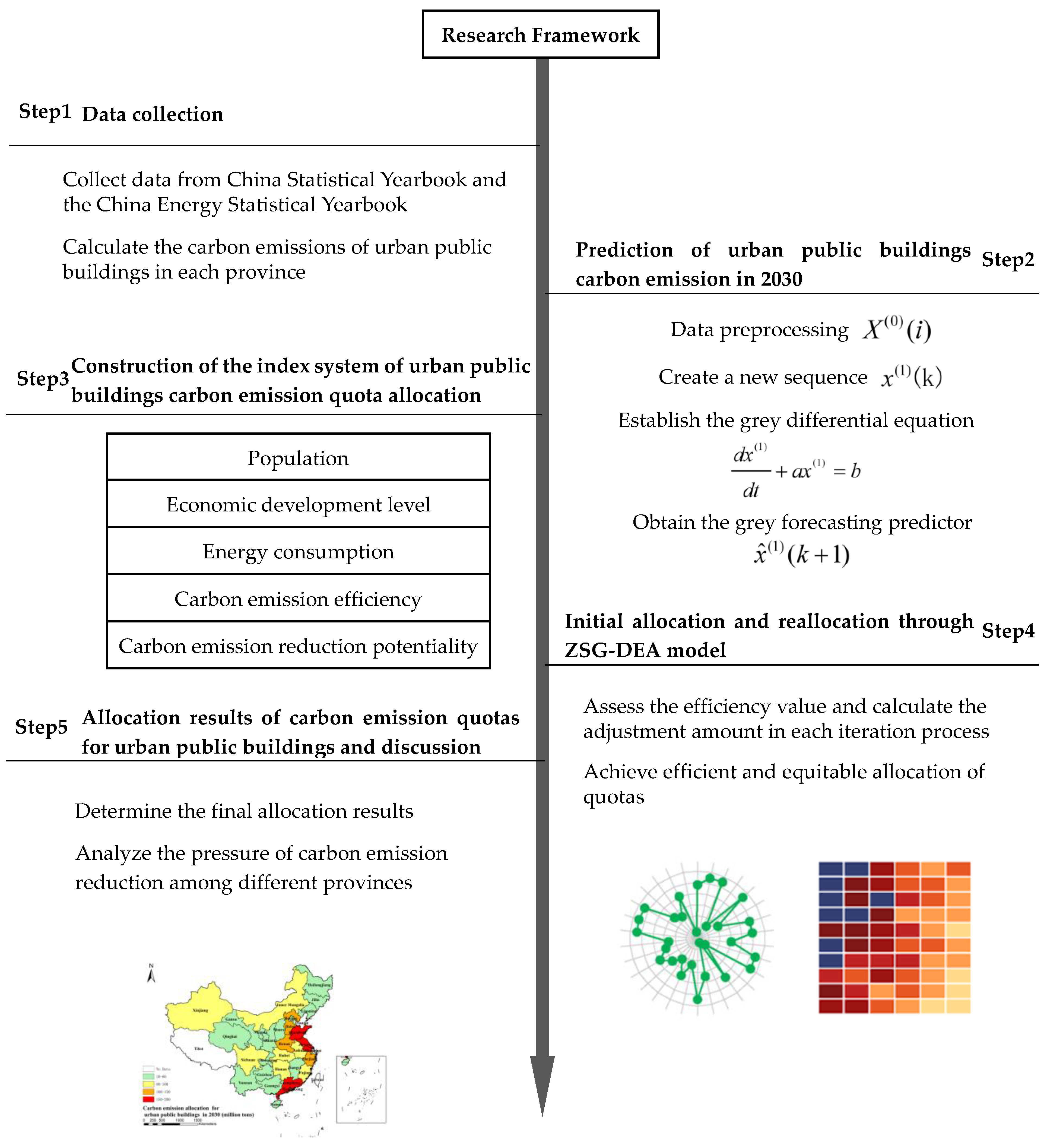
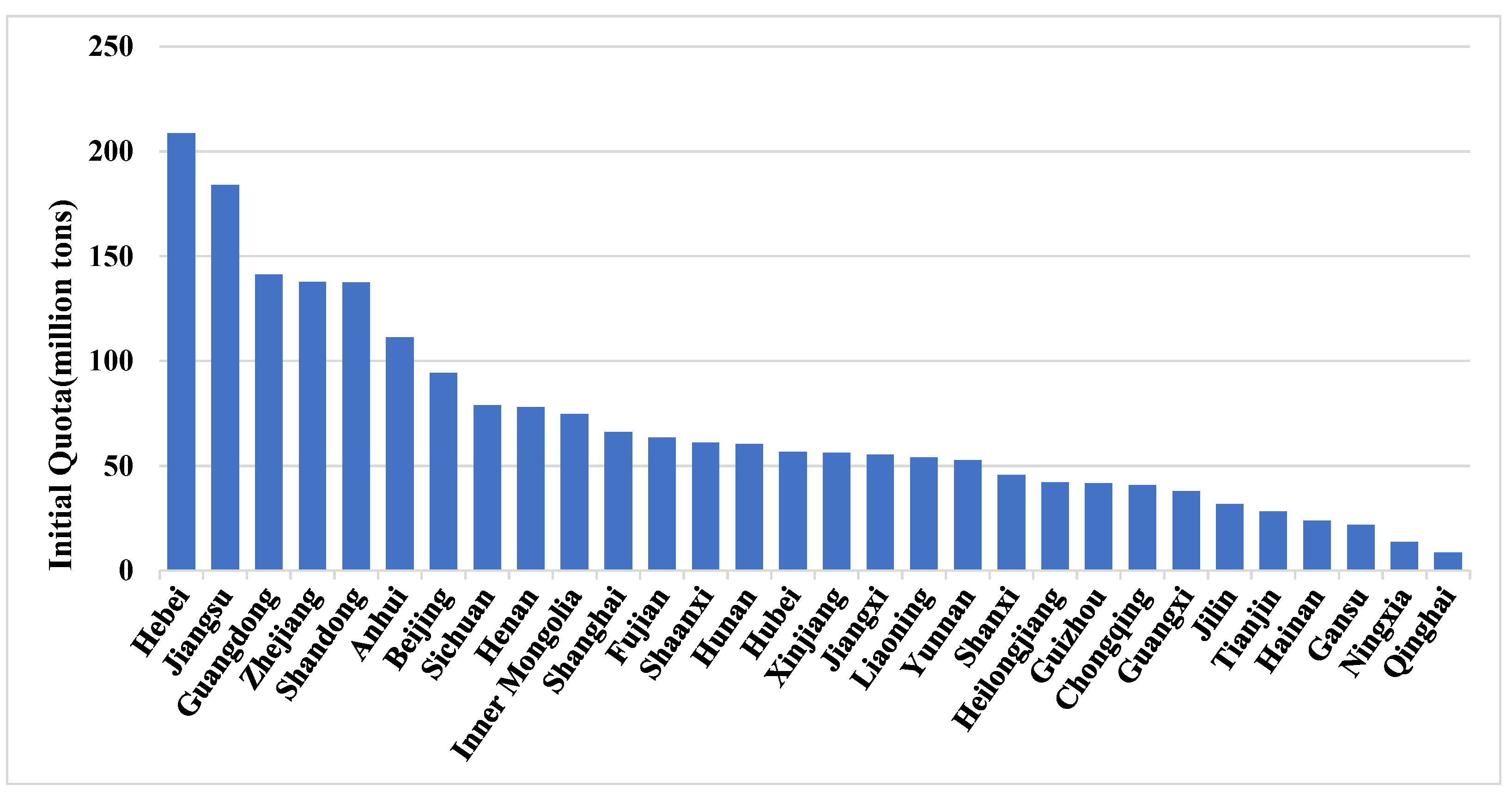
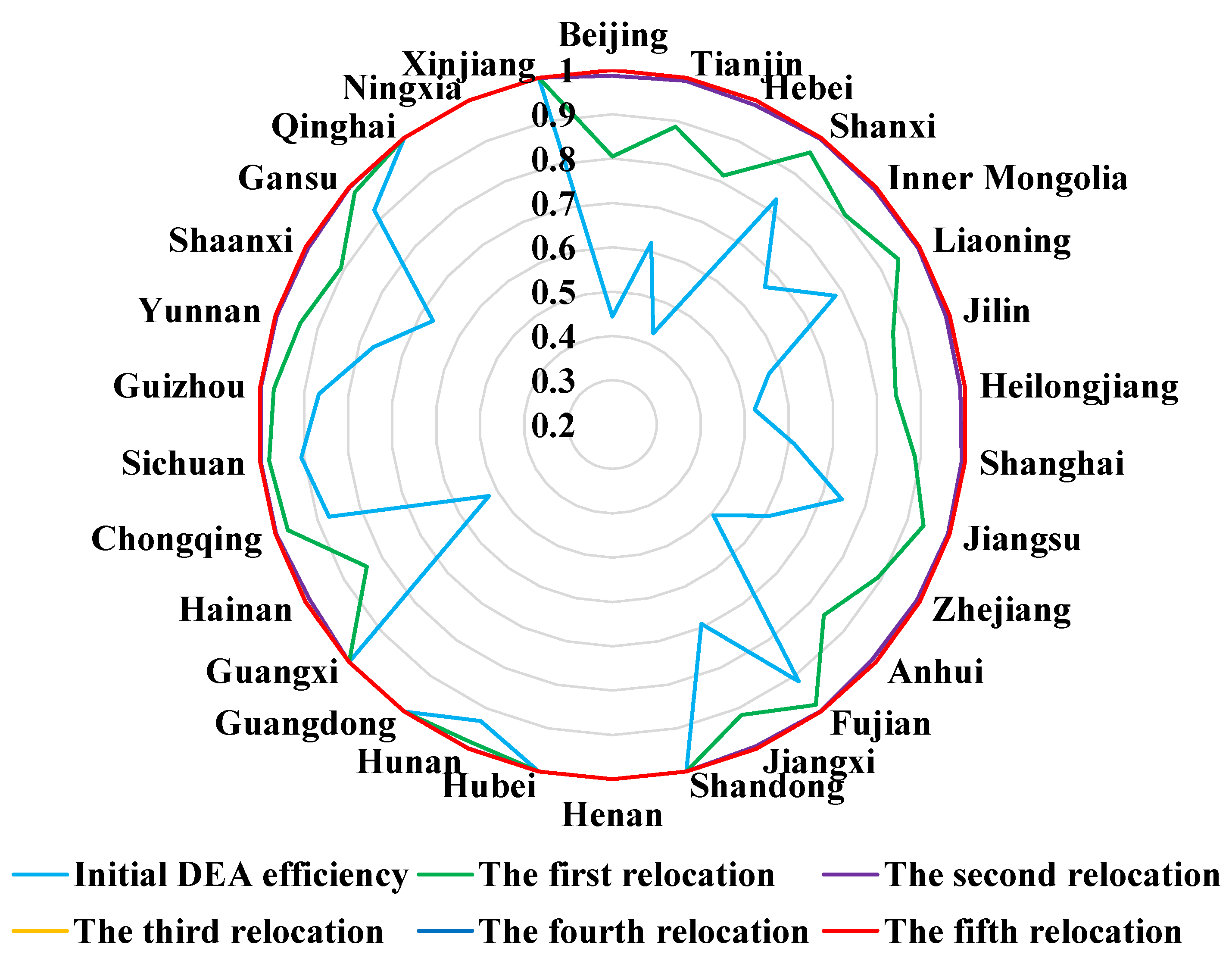
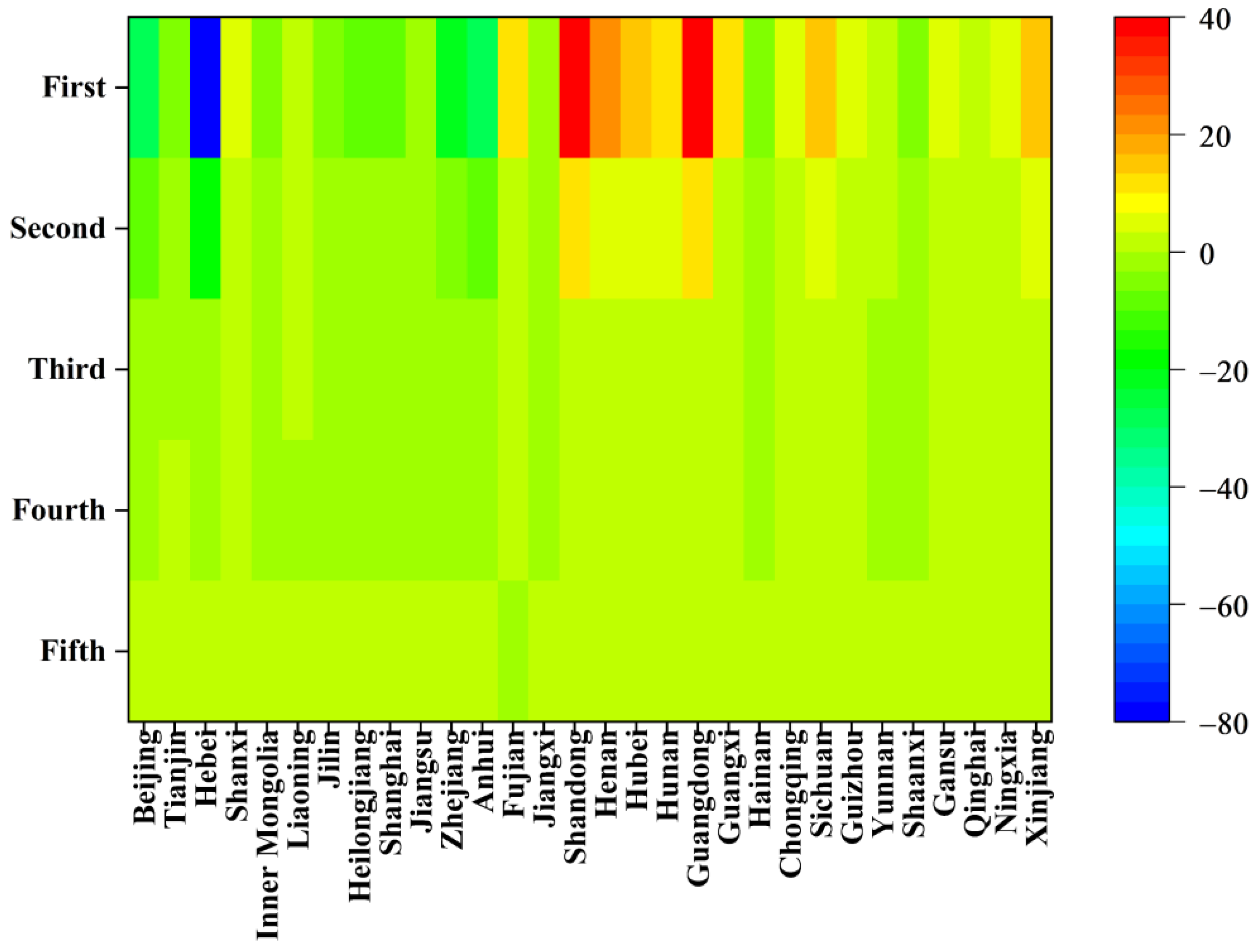
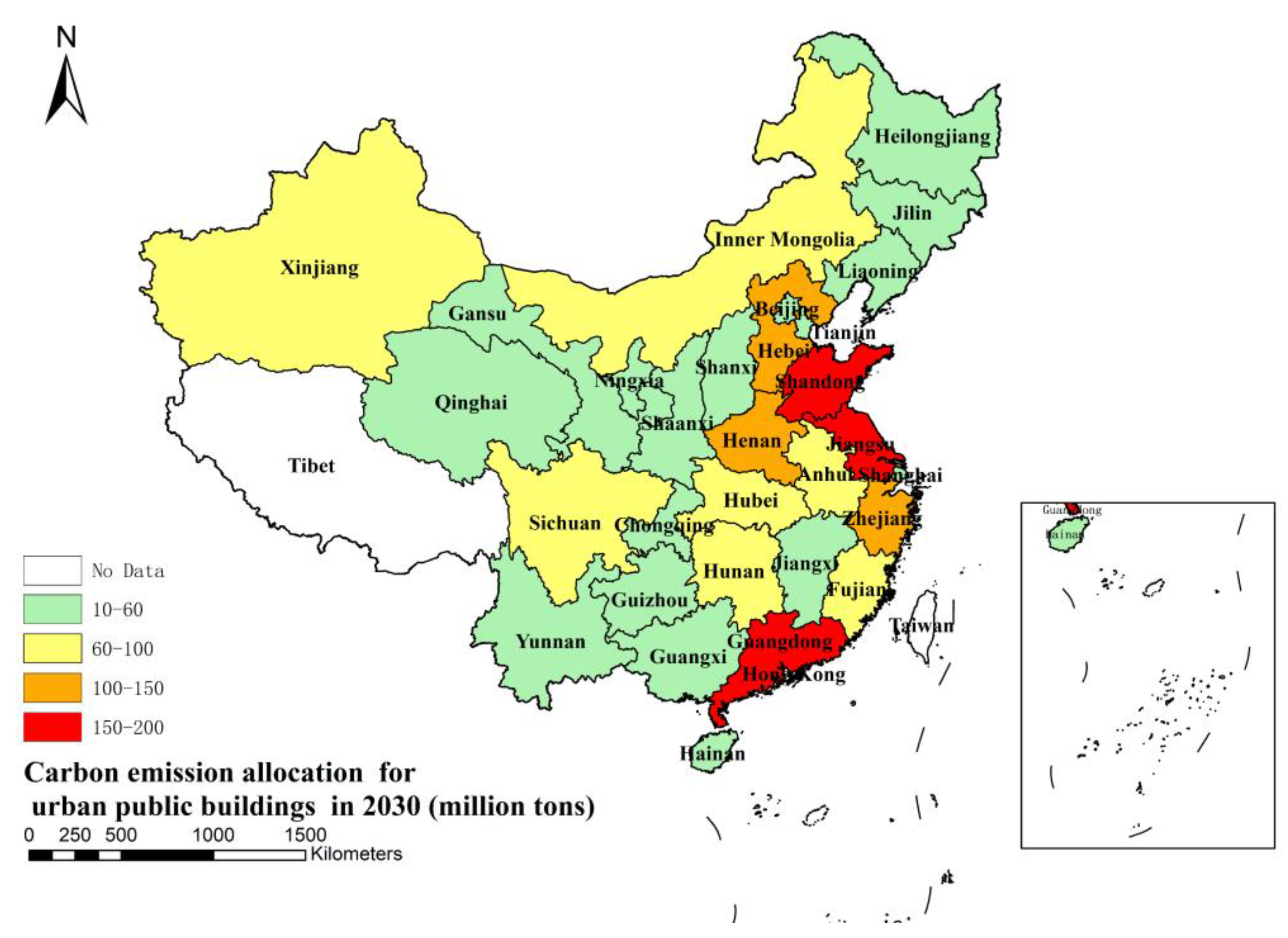
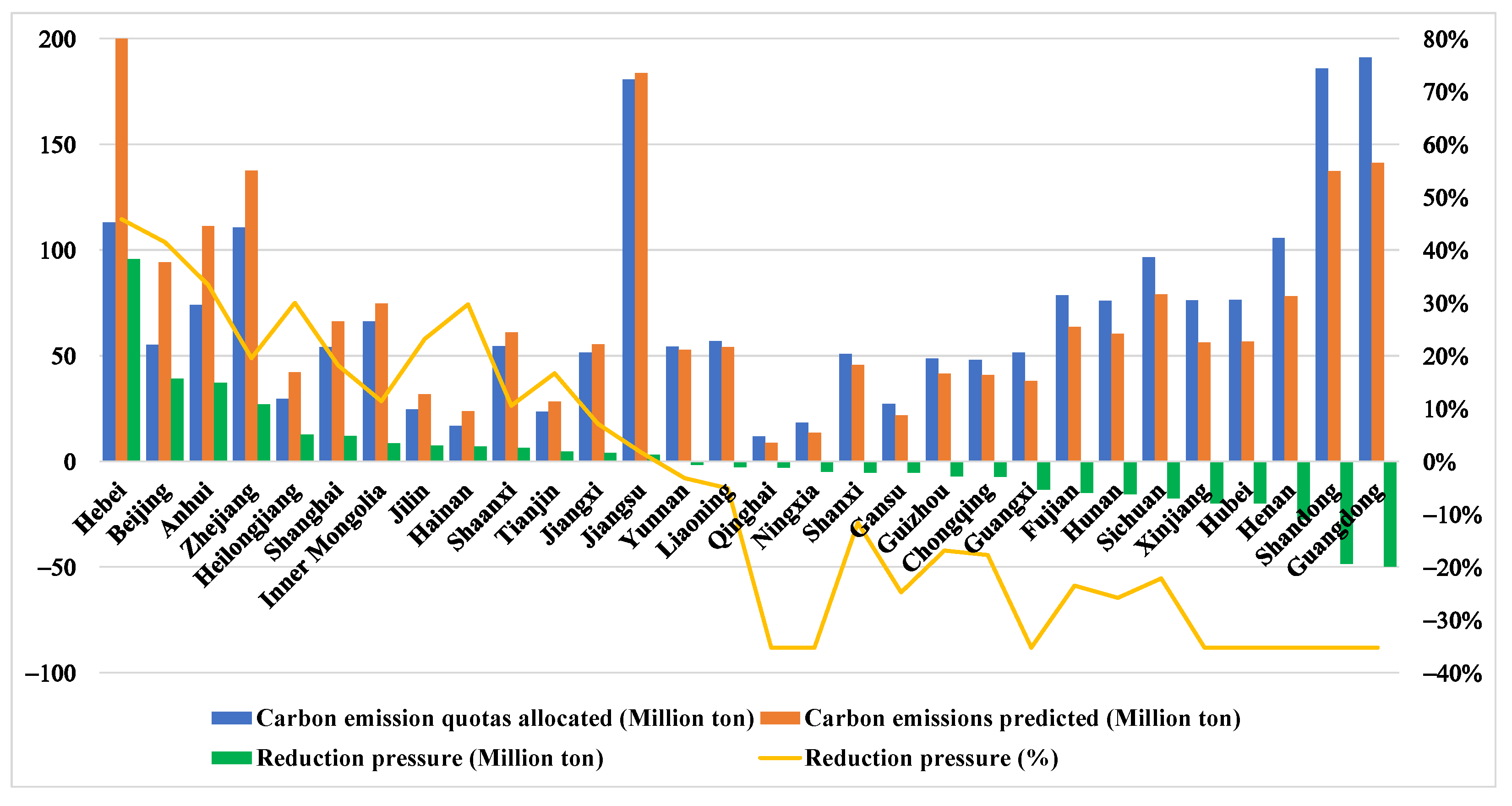
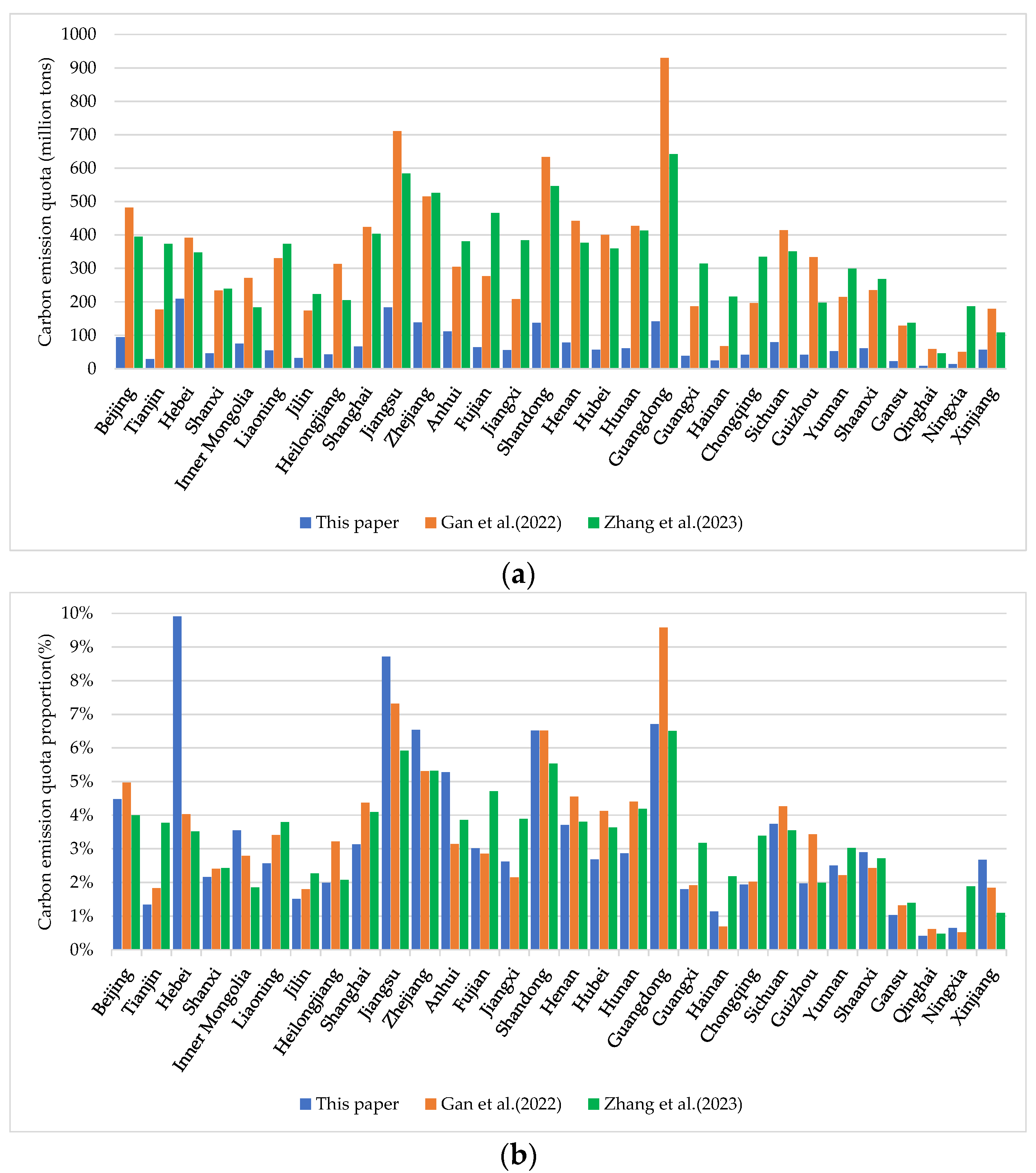
| Variable Classification | Specific Variable | Variable Explanation |
|---|---|---|
| Input variable | Population GDP Energy consumption | Population of each province in 2030 GDP of each province energy consumption of each province in 2030 |
| Output variable | Carbon emissions | Estimated CO2 emissions by regions of urban public buildings |
| Province | Carbon Quota (Million Tons) | Energy Consumption (Million Tce) | GDP (Billion Yuan) | Population (Million) |
|---|---|---|---|---|
| Beijing | 94.30 | 78.07 | 9454.55 | 24.70 |
| Tianjin | 28.30 | 93.16 | 3166.36 | 14.80 |
| Hebei | 208.77 | 388.43 | 7575.23 | 77.81 |
| Shanxi | 45.61 | 245.37 | 3586.52 | 34.77 |
| Inner Mongolia | 74.69 | 354.29 | 4027.39 | 23.56 |
| Liaoning | 54.11 | 249.38 | 4585.15 | 41.57 |
| Jilin | 31.84 | 54.05 | 2397.51 | 21.31 |
| Heilongjiang | 42.03 | 117.17 | 2255.15 | 26.84 |
| Shanghai | 66.05 | 125.82 | 9230.37 | 27.03 |
| Jiangsu | 183.81 | 413.61 | 27,641.29 | 90.95 |
| Zhejiang | 137.66 | 319.70 | 16,398.45 | 76.59 |
| Anhui | 111.31 | 200.38 | 11,932.85 | 61.75 |
| Fujian | 63.57 | 196.03 | 13,902.60 | 46.86 |
| Jiangxi | 55.34 | 156.28 | 7415.71 | 45.94 |
| Shandong | 137.41 | 500.11 | 16,645.72 | 107.78 |
| Henan | 78.16 | 231.83 | 14,505.83 | 103.84 |
| Hubei | 56.55 | 189.89 | 13,680.23 | 60.13 |
| Hunan | 60.44 | 166.87 | 11,812.72 | 67.71 |
| Guangdong | 141.23 | 461.97 | 29,017.68 | 151.85 |
| Guangxi | 37.97 | 165.91 | 6077.94 | 53.25 |
| Hainan | 23.82 | 38.82 | 1612.12 | 11.62 |
| Chongqing | 40.84 | 100.34 | 8053.32 | 35.64 |
| Sichuan | 78.93 | 232.33 | 14,404.98 | 86.44 |
| Guizhou | 41.51 | 130.36 | 7308.79 | 41.29 |
| Yunnan | 52.61 | 173.13 | 7792.94 | 48.29 |
| Shaanxi | 61.01 | 211.84 | 7436.71 | 41.68 |
| Gansu | 21.75 | 101.15 | 2077.54 | 24.51 |
| Qinghai | 8.70 | 67.89 | 859.95 | 6.24 |
| Ningxia | 13.61 | 177.15 | 1048.71 | 8.17 |
| Xinjiang | 56.33 | 409.45 | 3771.64 | 30.43 |
| Province | Initial Efficiency | Final Efficiency | Adjustment Amount (Million Tons) | Final Quota (Million Tons) |
|---|---|---|---|---|
| Hebei | 0.42576 | 1 | 95.67 | 113.1 |
| Beijing | 0.44369 | 1 | 39.14 | 55.16 |
| Anhui | 0.50604 | 1 | 37.16 | 74.15 |
| Hainan | 0.52254 | 1 | 7.08 | 16.74 |
| Heilongjiang | 0.52267 | 1 | 12.61 | 29.42 |
| Jilin | 0.57153 | 1 | 7.38 | 24.46 |
| Zhejiang | 0.61115 | 1 | 26.87 | 110.79 |
| Shanghai | 0.61239 | 1 | 12.02 | 54.03 |
| Tianjin | 0.61939 | 1 | 4.71 | 23.59 |
| Inner Mongolia | 0.66326 | 1 | 8.49 | 66.2 |
| Shaanxi | 0.66807 | 1 | 6.42 | 54.59 |
| Jiangxi | 0.69239 | 1 | 3.93 | 51.41 |
| Jiangsu | 0.74473 | 1 | 3.04 | 180.77 |
| Yunnan | 0.76735 | 1 | −1.68 | 54.29 |
| Liaoning | 0.78163 | 1 | −2.78 | 56.89 |
| Shanxi | 0.82855 | 1 | −5.31 | 50.92 |
| Guizhou | 0.86662 | 1 | −7.01 | 48.52 |
| Chongqing | 0.87262 | 1 | −7.25 | 48.09 |
| Sichuan | 0.90653 | 1 | −17.51 | 96.44 |
| Fujian | 0.91565 | 1 | −14.97 | 78.54 |
| Gansu | 0.92357 | 1 | −5.4 | 27.15 |
| Hunan | 0.93201 | 1 | −15.6 | 76.04 |
| Shandong | 1 | 1 | −48.47 | 185.88 |
| Henan | 1 | 1 | −27.56 | 105.72 |
| Hubei | 1 | 1 | −19.95 | 76.5 |
| Guangdong | 1 | 1 | −49.82 | 191.05 |
| Guangxi | 1 | 1 | −13.39 | 51.36 |
| Qinghai | 1 | 1 | −3.07 | 11.77 |
| Ningxia | 1 | 1 | −4.79 | 18.4 |
| Xinjiang | 1 | 1 | −19.86 | 76.19 |
Disclaimer/Publisher’s Note: The statements, opinions and data contained in all publications are solely those of the individual author(s) and contributor(s) and not of MDPI and/or the editor(s). MDPI and/or the editor(s) disclaim responsibility for any injury to people or property resulting from any ideas, methods, instructions or products referred to in the content. |
© 2023 by the authors. Licensee MDPI, Basel, Switzerland. This article is an open access article distributed under the terms and conditions of the Creative Commons Attribution (CC BY) license (https://creativecommons.org/licenses/by/4.0/).
Share and Cite
Zhang, Z.; Liu, Y.; Du, Z. CO2 Emission Allocation for Urban Public Buildings Considering Efficiency and Equity: An Application at the Provincial Level in China. Buildings 2023, 13, 1570. https://doi.org/10.3390/buildings13061570
Zhang Z, Liu Y, Du Z. CO2 Emission Allocation for Urban Public Buildings Considering Efficiency and Equity: An Application at the Provincial Level in China. Buildings. 2023; 13(6):1570. https://doi.org/10.3390/buildings13061570
Chicago/Turabian StyleZhang, Zhidong, Yisheng Liu, and Zhuoqun Du. 2023. "CO2 Emission Allocation for Urban Public Buildings Considering Efficiency and Equity: An Application at the Provincial Level in China" Buildings 13, no. 6: 1570. https://doi.org/10.3390/buildings13061570
APA StyleZhang, Z., Liu, Y., & Du, Z. (2023). CO2 Emission Allocation for Urban Public Buildings Considering Efficiency and Equity: An Application at the Provincial Level in China. Buildings, 13(6), 1570. https://doi.org/10.3390/buildings13061570






